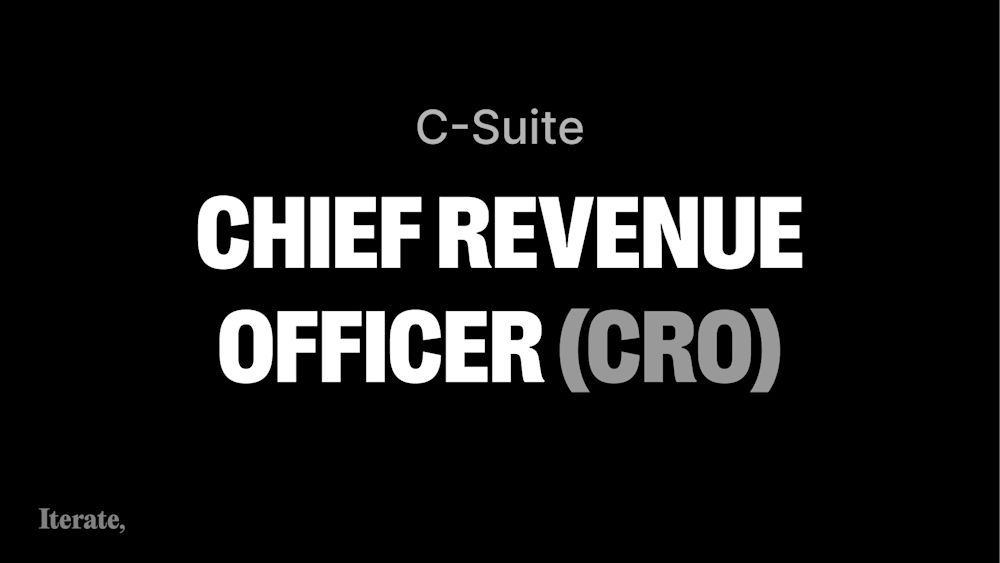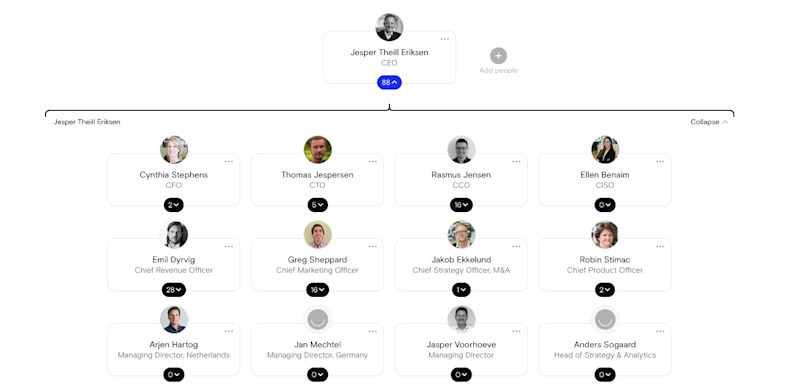- Iterate
- Job Titles
- What is a Chief Revenue Officer?
Table of contents
In this guide we will explore what a chief revenue officer is and why they are beneficial for any organization looking to scale.

In the tech industry, jargon like “high-growth,” “growth hacker” and “scale” gets tossed around all the time. This is because startups have to be growth-oriented to sustain themselves, receive funding, IPO and stay relevant in an ever-changing and saturated market. Over the past decade, this rapid growth mindset has led to an increase in popularity of one position in particular: Chief Revenue Officer.
According to Linkedin, there was a 73% increase in chief revenue officer titles from the years 2015 to 2018, which speaks to the heightened importance of generating revenue to support organizational growth. In this guide we will explore what a chief revenue officer is and why they are beneficial for any organization looking to scale.
What is a Chief Revenue Officer?
A chief revenue officer (CRO) is a senior-level executive that is responsible for overseeing all business functions that impact the revenue generation of an organization. This leader works across many teams to ensure that each product is generating as much revenue as possible, customers are satisfied and distribution is effective. Although every organization does not need to have a CRO in operation, every business must have strategies set in place that will guarantee their organization is profitable and sustainable.
Visually, the CRO sits within the C-level of a corporate hierarchy and reports to the Chief Executive Officer on all matters surrounding the company’s revenue. The teams that report into the CRO usually include revenue operations, sales, customer success and marketing. To provide a better understanding of where the chief revenue officer sits within an organizational structure, here is an example:

Templafy’s chief revenue officer, Emil Dyrvirg, sits alongside fellow C-suite executives and they all report to the CEO. Below Dyrvig are the sales and partnerships teams.
Responsibilities of a CRO
While a CRO can often have a sales background, they are not to be confused with a VP of sales. The VP of sales solely oversees the sales team and is responsible for setting sales strategies and making sure all KPIs are met. On the other hand, a CRO manages and connects all teams that contribute to driving new business. Some of their responsibilities include but are not limited to:
- Foster alignment between all revenue-related teams, and work closely with all revenue-related teams.
- Analyze data to make strategic decisions and define relevant KPIs that will maximize revenue production.
- Work with marketing teams to ensure all efforts are impactful and subsequently monitor campaign performance.
- Collaborate with product leaders to identify market value and ensure product pricing is accurate.
- Monitor sales performance and provide strategies and tactics to increase the organization’s profit.
- Create new streams of recurring revenue and provide all teams with the resources needed to be successful.
- Forecast growth over the organization's long term
What is the difference between a CFO and CRO?
Although the chief financial officer’s (CFO) and the chief revenue officer’s positions both center around money, their roles and responsibilities are vastly different. For starters, the CFO monitors where all the business’s money is going, while the CRO is making sure new cash is coming into the business. The chief financial officer’s purpose is to manage the organization’s finances so they oversee teams that are responsible for budgeting, accounting and risk management. The CFO also monitors expenditures and maps out long-term financial plans.
In contrast, the chief revenue officer is responsible for meeting revenue and earnings goals and ensuring the cash flow is consistent. While the CRO and CFO are dependent on each other for success and may even work together, they are tasked with different responsibilities and head up separate departments.
The skills of a CRO
To become a chief revenue officer one must have a strong background and skill set. Here are some of the competencies that make a successful CRO.
Leadership
The chief revenue officer of an organization heads up multiple teams so they must have been an excellent leader. They should have experience managing large groups of people, collaborating cross-functionally and inspiring and guiding those below them.
Communication
A chief revenue officer is responsible for aligning multiple teams and liaising with many key stakeholders and executives. This means that the successful CRO should be an excellent communicator in order to explain and support important decisions made to keep the business growing.
Business growth
CROs should already have general growth experience, whether that be in sales, business development, marketing, or product development. When bringing it into an executive-level role, this individual will need to combine growth hacking methods with business operations. They should be great at identifying problems, creating optimal solutions and discovering new opportunities for revenue generation.
Customer-driven
A great CRO should be customer-focused. To create successful products and grow a business, this leader has to be in tune with who their customers are and what they need. This way, the CRO can guide sales, marketing and product teams on how to best satisfy their market.
Data and analytics
A CRO should have significant data analysis experience because this is a highly data-driven role. This leader will often use data to make informed decisions and set company-wide metrics.
Chief Revenue Officers have a lot of responsibility—they ensure that the business will not only stay afloat but continually grow in measurable sales and value. If you are mapping out your own path to the CRO position, a good place to start would be joining your company’s public org chart. This allows you to better understand where you sit in your own team and the steps you need to take to make it to chief status.
Create your own free org chart today!
Show off your great team with a public org chart. Build a culture of recognition, get more exposure, attract new customers, and highlight existing talent to attract more great talent. Click here to get started for free today.

